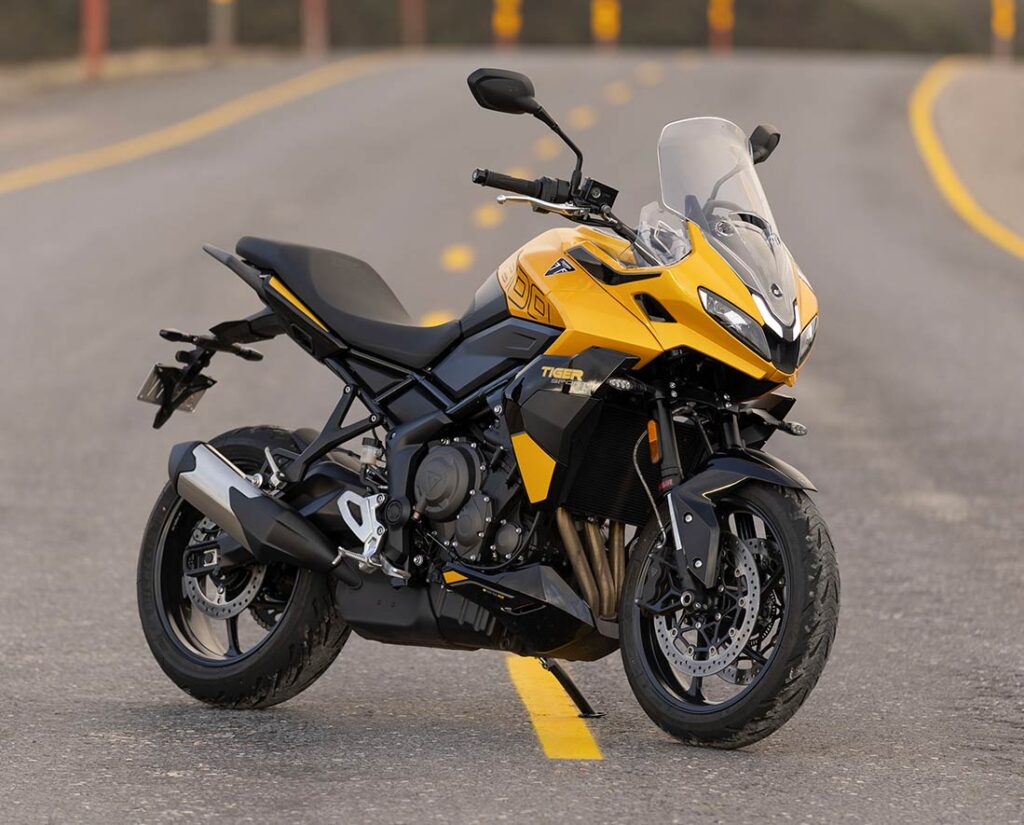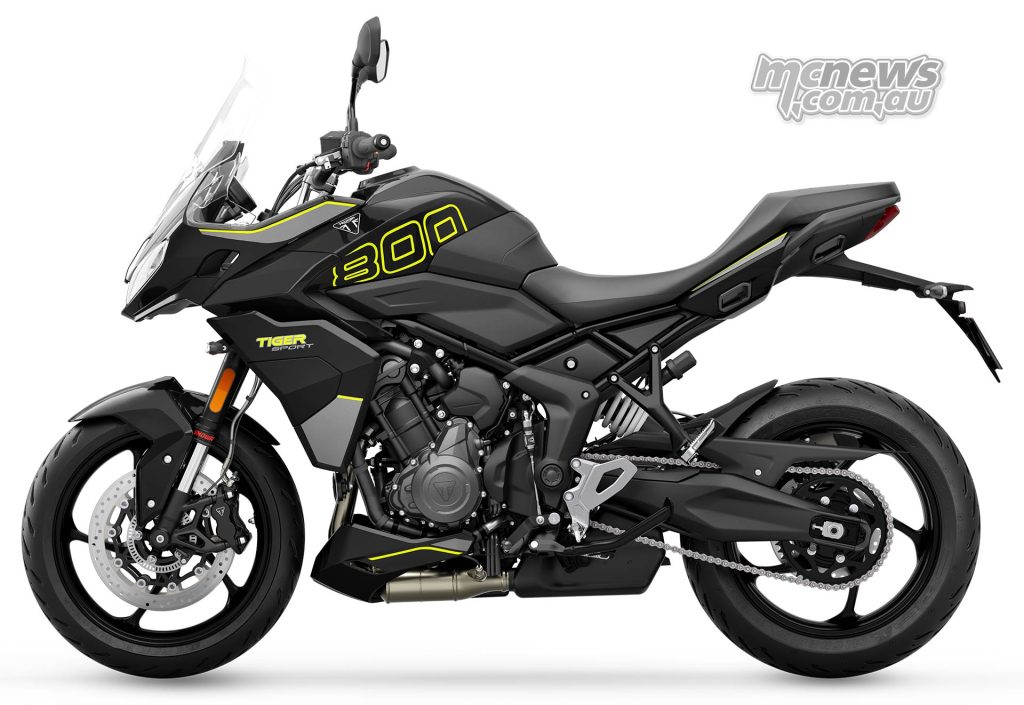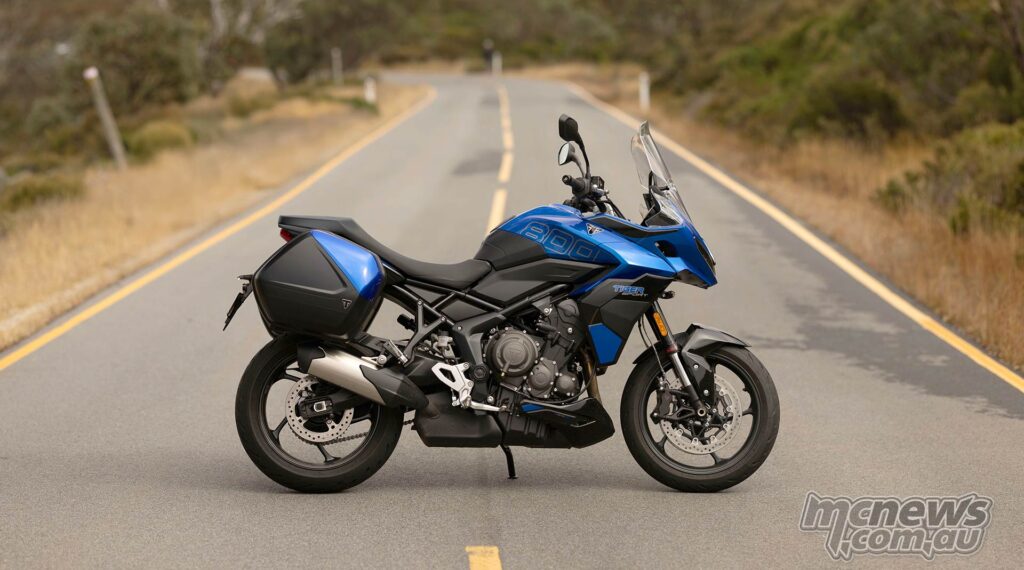Triumph Tiger Sport 800 Review
The current trend among motorcycle manufacturers to transform their adventure platforms into more road-focussed options, catering to riders less inclined towards off-road pursuits, continues unabated with the arrival of the new Tiger Sport 800.
Once upon a time, Triumph would have offered a fully-faired sports-tourer built upon these mechanical foundations, something akin to the old Trophy models. However, such bikes are rare today, and Triumph is simply aligning with market demands.

Undoubtedly, Triumph and other manufacturers leverage extensive market research to reach these conclusions before committing substantial budgets to develop these motorcycles. While I can’t be the only one who yearns for long, low-slung, fully-faired sports-tourers, tastefully painted in a solid colour, I must be in the minority.
I do, however, hold onto hope. As this Tiger Sport 800 model introduces a new engine that will be incorporated into a variety of other, yet-to-be-announced models, Triumph may yet surprise us…

Anyway, I digress. Let’s delve into this new Tiger 800 Sport, which I was recently lucky enough to experience over an enjoyable couple of days in the Victorian High Country.
That new 798 cc triple is a cracker. It evokes more memories of the vivacious Street Triple rather than the “hammer in velvet glove” that is the 1200 Speed Triple.
It’s lively, eager to rev, and feels, despite its trio of throttle bodies, modern design, and impressive power delivery, a little, well, analogue – and I mean that in a good way.

It will no doubt make its way into a variety of coming models
So often these days, motorcycle engines can have a little of their visceral edges polished off in their pursuit of perfect throttle response, fuel economy and EU satisfying unicorn fart emissions levels, but I didn’t really get any hint of that from this new engine.
It remains smooth and exhibits no coarseness, yet somehow feels a little more alive and organic than many of its contemporaries. I quickly grew to appreciate this sensation, and while the engine is quite torquey and pulls pretty well from down low, the ‘little’ triple relished having the tits revved off it too. It entertained me well enough.

The numbers? 113 horsepower at 10,750 rpm, and 84 Nm at 8500 rpm, with at least 90 per cent of that peak torque number apparent throughout the majority of the entire rev range.
It doesn’t quite have the punch to match the discontinued Tiger Sport 1050, but it is a noticeable step up in grunt over its most immediate predecessor, the T-Plane cranked Tiger 850 Sport.
The new Tiger Sport 800 also boasts a little more power than the current Tiger 900 range that utilises the contemporary 888 cc T-plane cranked triple. Not bad going considering this new engine has almost 100 cc less displacement. However, some will miss those gravelly T-plane harmonics, as the Tiger Sport 800 runs a conventional 120-degree crank.

You feel you are really using all of the engine’s potential when having a crack, which is satisfying in itself. I rate the engine quite highly and think it really does offer everything you want in a street-focussed motor.
The two-way quick-shift worked well, and the gearbox gave me no complaints.

Likewise, the radial four-piston stoppers and 310 mm rotors offered a good balance of power and control. Not top shelf good, but plenty good enough.
Riding on 17-inch rims shod with fairly sporty 120/70 and 180/55 rubber, the Tiger is a willing partner when it comes time to play. More so than many of its contemporaries that roll on a compromising 19-inch front.

Showa provides the suspension at both ends in what I would describe as a fairly mid-range specification.
The inverted 41 mm forks feature a compression circuit in one leg and rebound in the other, both of which are adjustable. The shock features rebound damping adjustment and a convenient hydraulic preload adjuster.
Travel is a generous 150 mm at both ends, which also means you have plenty of ground clearance.

It all works pretty well, but when pressing on across less-than-perfect tarmac, the forks can start to oscillate a little as the damping struggles to maintain fine control. That said, I had just swapped onto the Tiger from the latest Triumph Speed Triple RS that glides on the latest generation top-shelf Ohlins electronic kit that is other worldly good, so had just been somewhat spoiled.
It feels lighter than its 214 kg wet weight might suggest and carries that weight well. It points into and rails a turn with agility, while offering relaxed upright ergonomics and decent comfort levels. It just all happens pretty easily.
An 18.5 litre fuel tank provides a touring range in excess of 300 kilometres. Cruise control is standard, which is nice to see at this 20k ride-away price point. Heated grips will cost you $380 and tyre pressure monitoring $456.

The screen is easily adjusted on the fly and does a pretty good job of protecting you from the elements.
The listed seat height is 835 mm, but it is slim between the knees, and shorter folk will still find it quite amenable.

If you are at all familiar with my scribblings about bikes, you will know how much I appreciate cleverly integrated pannier mounts. Pannier racks and external piped framing for luggage has always looked shit, and will always look shit. Even worse, they also place the added weight a long way from the bike’s centreline and often turn a finely tuned chassis into a lumbering barge.

Triumph has done a great job on the almost completely flush mounts for the optional panniers, which themselves integrate nicely into the bike’s lines, especially when the colour-matched option is ticked when adding panniers. Win.

You have three riding modes that tailor the cornering ABS and (switchable) traction control interventions to suit their descriptive names, ‘Sport’, ‘Road’ and ‘Rain’. The electronic systems are all fed data from a six-axis IMU. I am getting a little bored with ride modes to be honest, so won’t bore you too much with them here, they do what they say on the tin, nuff said.
The instrumentation and switch-gear are a little basic for a new 2025 model, but they fulfil their core mission of displaying the data and operability you require well enough. Still, the dash is always in your view and thus it would be nice if it looked a little less, well, Fisher-Price.

Bluetooth connectivity allows navigation cues to be displayed on the dash when paired with the Triumph App on your smartphone. Nice.
Service intervals are a long 16,000 kilometres apart which should help to keep the cost of ownership affordable for those planning to really get out and about on the new Tiger Sport 800. Valve clearances are required every 32,000 km. However, it would be nice if Triumph extended their warranty coverage past the 24-month period on offer to match some of their competitors.

Without the panniers, the yellow was certainly my pick, but when the colour-matched panniers are added, the blue bike really starts to pop too. I appreciate the lack of graphics, acronyms and needless badging, makes the whole show look a little press pretentious.

At a tick over 20 k ride away, the Tiger Sport 800 does have plenty to offer. The optional panniers are less than a grand for the pair, which makes them a no-brainer.

Curiously, like pretty much the entire Triumph range, the Tiger Sport 800 is more affordable here in Australia than it is in the UK.
For just over $21k, complete with factory luggage, you have a comfortable, well-equipped and versatile jack-of-all-trades sports-tourer cum commuter. In today’s market, that’s pretty good value indeed, especially once you factor in the sheer amount of “feel-good” fun factor the new Tiger Sport 800 exudes. Practicality, but with a good dose of personality. I would say that is the design brief pretty well met…

Triumph Tiger Sport 800 Specifications
| 2025 Triump Tiger Sport 800 Specifications | |
| Type | Liquid-cooled, 12 valve, DOHC, inline 3-cylinder |
| Capacity | 798 cc |
| Bore | 78.0 mm |
| Stroke | 55.7 mm |
| Compression | 13.2:1 |
| Maximum power | 113 hp (84.6 kW) at 10,750 rpm |
| Maximum torque | 84 Nm at 8500 rpm |
| Fuel system | Bosch Multipoint sequential electronic fuel injection, rbw, rider modes |
| Exhaust | Stainless steel 3-into-1 header system, side-mounted stainless-steel silencer |
| Final drive | X-ring Chain |
| Clutch | Wet, multi-plate, slip and assist |
| Gearbox | 6-speed, Triumph Shift Assist |
| Frame | Tubular steel perimeter frame. |
| Swingarm | Twin sided fabricated pressed steel |
| Front wheel | Cast alloy, five-spoke 17 x 3.5″ |
| Rear wheel | Cast alloy, five-spoke 17 x 5.5″ |
| Front tyre | 120/70-17 |
| Rear tyre | 180/55-17 |
| Front Suspension | Showa 41mm, upside-down separate function cartridge forks, adjustable compression and rebound damping, 150mm wheel travel |
| Rear Suspension | Showa monoshock RSU with adjustable rebound damping and remote hydraulic preload adjustment, 150mm wheel travel |
| Front brakes | Twin Ø310mm floating discs, 4-piston radial calipers, OCABS |
| Rear brakes | Single 255mm disc. Single piston sliding caliper. Optimised cornering ABS |
| Instruments | LCD Multifunction Instruments with integrated colour TFT screen |
| Length | 2073 mm |
| Width (handlebars) | 828 mm |
| Height without mirrors | Adjustable 1386-1303mm (high / low screen position) |
| Seat height | 835 mm |
| Wheelbase | 1422 mm |
| Rake / Trail | 23.8° / 99 mm |
| Wet weight | 214 kg |
| Fuel tank capacity | 18.6 litres |
| Fuel Consumption** | 60.1 mpg (4.7 litres / 100 km) |
| CO2 Figures** | 109 g/km |
| Standard** | EURO 5+ |
| Service interval | 16,000km or 12 months (valve clearances ever 32,000km) |











